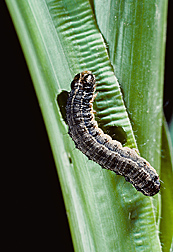This page has been archived and is being provided for reference purposes only. The page is no longer being updated, and therefore, links on the page may be invalid.
| Read the magazine story to find out more. |
|
|
Versatile Compound Examined in Crops
By Jan SuszkiwAugust 2, 2011
Detergent-like compounds called saponins are best known for their cleansing properties, but U.S. Department of Agriculture (USDA) scientists are studying these compounds' potential for helping protect plants from insect attack.
In studies at the National Center for Agricultural Utilization Research, operated in Peoria, Ill., by the Agricultural Research Service (ARS), scientists Pat Dowd, Mark Berhow and Eric Johnson are "spiking" laboratory diets fed to corn earworms and fall armyworms with saponins from soybeans, switchgrass, yerba mate and other sources to determine exactly what effects the compounds have on the caterpillar pests' growth and survival. ARS is USDA's principal intramural scientific research agency.
The saponin experiments are part of a broader research effort at Peoria to identify novel sources of resistance that can be incorporated into corn. Ultimately, this could usher in new corn varieties that sustain less caterpillar feeding damage, are less prone to toxic molds or require fewer pesticide applications.
Most grain crops, including corn, don't have saponins in them, according to Dowd, with the center's Crop Bioprotection Research Unit. However, ongoing studies of switchgrass, a distant relative, may reveal dormant genes or biochemical pathways that could be activated in corn using plant breeding or genetic engineering methods.
One lead the Peoria researchers are investigating came from geneticist Ken Vogel and his colleagues at the ARS Grain, Forage and Bioenergy Research Unit in Lincoln, Neb. In studies there, Vogel's team identified two saponins in switchgrass a steroidal type called diosgenin, and a related form called protodioscin that they suspect helped several germplasm lines of the promising biofuel crop resist fall armyworms.
Dowd's team conducted follow-up experiments in which diosgenin and protodioscin were fed to the pests and compared to saponins from mate, soap bark tree and soybeans and other sources. Protodioscin, like the others, showed activity against fall armyworms, but the most effective ones seemed to be those containing a sugar molecule. Soyasaponin B, for example, reduced the growth of corn earworms by more than 50 percent. Smaller caterpillars, in turn, can mean less crop damage and easier pickings by predators.
Read more about this research in the August 2011 issue of Agricultural Research magazine.

